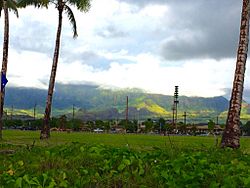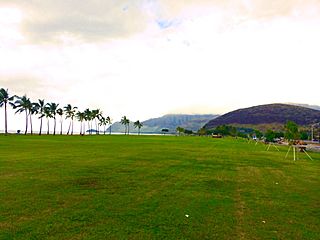Māʻili, Hawaii facts for kids
Quick facts for kids
Māʻili
|
|
|---|---|

Māʻili with the Lualualei Valley and the Waianae Range in the background.
|
|

Location in Honolulu County and the state of Hawaii
|
|
| Country | United States |
| State | Hawaii |
| Area | |
| • Total | 2.80 sq mi (7.26 km2) |
| • Land | 1.71 sq mi (4.43 km2) |
| • Water | 1.09 sq mi (2.83 km2) |
| Elevation | 13 ft (4 m) |
| Population
(2020)
|
|
| • Total | 11,535 |
| • Density | 6,749.56/sq mi (2,605.80/km2) |
| Time zone | UTC-10 (Hawaii-Aleutian) |
| ZIP code |
96792
|
| Area code(s) | 808 |
| FIPS code | 15-47300 |
| GNIS feature ID | 0361999 |
Māʻili (pronounced maah-EE-lee) is a special area in Hawaii called a census-designated place (CDP). It is located in the Waiʻanae District on the island of Oʻahu. In the Hawaiian language, māʻili means "pebbly." This refers to the smooth, rounded stones often found on the shore.
Māʻili is found along Farrington Highway on Oʻahu's Leeward Coast. It sits between Māʻili Beach Park to the west and Lualualei Valley to the east. The town is about 1.4 miles south of Waianae and 1.5 miles north of Nanakuli. A stream called Māʻiliʻili Stream separates it from Waianae.
As of the 2020 census, about 11,535 people live in Māʻili. The town has a few shops, a gas station, and some homes. You can also find dairy farms and vegetable gardens here. Near the Lualualei Valley, two very tall red antennae stand out. These are part of the Navcom Radio Transmitting Facility. When they were built in 1972, they were the tallest human-made structures in the Western Hemisphere!
Māʻili has one of the highest percentages of Native Hawaiians in all of Hawaiʻi. About 48.8% of the people living here in 2009 were Native Hawaiian.
Contents
Māʻili Beach Park: A Fun Place to Visit
Māʻili and its waterfront park, Māʻili Beach Park, are very popular. People love to visit for surfing, snorkeling, swimming, and bodyboarding. The park covers about forty acres and is just south of Lualualei Beach Park.
Māʻili Beach Park is home to two well-known Hawaiian surf spots. One is called Green Lanterns, located near the Māʻiliʻili Stream. The other is Tumbleland, found in the middle of the beach park. The ocean can be rough in winter but is usually calm during summer. The beach park has a lifeguard station to keep everyone safe. It also has a playground, restrooms, picnic tables, and showers for visitors.
Geography of Māʻili
Māʻili is located at 21°25′6″N 158°10′43″W / 21.41833°N 158.17861°W. This means it is at 21.418333 degrees North latitude and -158.178736 degrees West longitude.
The area of Māʻili is about 7.3 square kilometers (2.8 square miles). Out of this, 4.4 square kilometers (1.7 square miles) is land. The remaining 2.8 square kilometers (1.1 square miles), which is about 38.92% of the total, is water.
The town is on the Waimea Coast of Oʻahu. It stretches from the ocean-front Māʻili Beach Park to the Lualualei Valley. The valley is at the bottom of the Waianae Range.
Population of Māʻili
| Historical population | |||
|---|---|---|---|
| Census | Pop. | %± | |
| 2020 | 11,535 | — | |
| U.S. Decennial Census | |||
In 2020, the population of Māʻili was 11,535 people. The community is made up of people from many different backgrounds. This includes White, African American, Native American, Asian, and Pacific Islander residents. Many people also identify as being from two or more races. A number of residents are also of Hispanic or Latino heritage.
In 2000, there were 1,359 households in Māʻili. Many households included children under 18. The average household had about 4.22 people living in it. The average family had about 4.35 people. The median age of people living in Māʻili was 28 years old.
Education in Māʻili
The Hawaii Department of Education is in charge of the public schools in Māʻili. Māʻili Elementary School is located right in the CDP.
For older students, Leeward Community College also has a campus called Waiʻanae Moku in Māʻili.
Gallery
See also
 In Spanish: Maili para niños
In Spanish: Maili para niños



